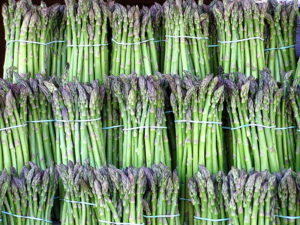Few veggies herald the advent of summer like asparagus spears emerging from underground. Asparagus appreciation dates back millennia, and Millennial bloggers continue to drive its demand today. This is a perennial plant with perennial popularity.

“There’s no other crop quite like asparagus,” summarizes Brenna Aegerter, Cooperative Extension Farm Advisor at the University of California. “Fields are started with one-year-old dormant crowns. Nothing is harvested in the first year. The second year it emerges from dormancy in the spring, crews harvest, but only for a week or two, at least in California. The third year, they still may not cut for the full season, depending on how strong it is.”
All that waiting. “And even over the course of a whole season, a yield of about two tons is tremendous,” she adds. “But of course, asparagus is high value.”
That is, if growers can beat the European asparagus aphid. While asparagus crops can generally remain productive for about 15 years, this aphid has abbreviated that lifespan for many fields.
Aegerter shared a 2009 CropLife Foundation publication by Leonard Gianessi, highlighting the dangers of this aphid. Though the numbers are a bit dated, the impacts are clear. “Asparagus aphids were first found in Washington in 1979, and in 1980, the aphid reduced asparagus stands by 35 percent,” he writes. “Asparagus aphids were first found in California in 1984; aphid pressure was so high in Riverside County that 85 percent of the production ceased.”
It’s easy to see why the recent registration of sulfoxaflor, facilitated by IR-4, will be enormously helpful. Growers who’ve diligently established a crop over the course of a few years, only to find that asparagus aphid has destroyed it, now have a viable tool to control this persistent pest.
Asparagus aphid produces a toxin, which it injects into the plant during feeding. “If you’ve had a colonization period of a week or two where it was feeding, then even if you control the aphid—and even if it doesn’t come back the next year—your plants are going to be disfigured,” Aegerter explains. “We call it bonsai growth, where the internodes don’t elongate, the fern is shorter and it looks like a little ball of leaves rather than being like a nice airy fern. Weirdly, the aphids are attracted to those plants. So often, the same areas in the field get impacted again and again until after a couple of years the aphids, if they’re not controlled, will actually kill the plants.
“So this aphid’s pretty bad,” she states. “Usually, unless they’re vectoring (bringing in a virus), you don’t think of aphids is being that bad—it’s not like a plague. But this one’s bad.”
And before this registration of sulfoxaflor, options for controlling it were pretty bad, too. “We were trying to move away from chlorpyrifos, an organophosphate, which was showing up in drainage water. Very recently, California pulled the plug on it,” Aegerter says.
“We have a couple of products registered that are softer chemistries than chlorpyrifos but they just aren’t that good,” she continues. “That’s why we’re excited to have something that is softer and seems to work.
PR# 11321 Aspargus (European Asparagus Aphid)
Katie Chriest is a freelance technical writer in Erie, Pennsylvania; kmc503@psu.edu.
